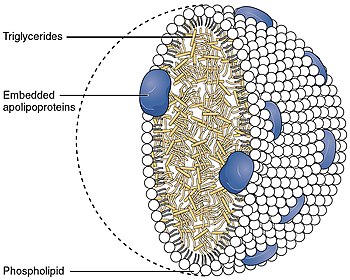Intermediate-density lipoprotein
Intermediate-density lipoproteins (IDLs) belong to the
LDL, HDL) that enable fats and cholesterol to move within the water-based solution of the bloodstream. Each native IDL particle consists of protein that encircles various lipids, enabling, as a water-soluble particle, these lipids to travel in the aqueous blood environment as part of the fat transport system within the body. Their size is, in general, 25 to 35 nm in diameter, and they contain primarily a range of triglycerides and cholesterol esters. They are cleared from the plasma into the liver by receptor-mediated endocytosis, or further degraded by hepatic lipase to form LDL particles.[citation needed
]
Although one might intuitively assume that "intermediate-density" refers to a density between that of high-density and low-density lipoproteins, it in fact refers to a density between that of low-density and very-low-density lipoproteins.[citation needed] In general, IDL, somewhat similar to low-density lipoprotein (LDL), transports a variety of triglyceride fats and cholesterol and, like LDL, can also promote the growth of atheroma.[citation needed]
cholesteryl esters. Some of the IDL particles are rapidly taken up by the liver; others remain in circulation, where they undergo further triglyceride hydrolysis by hepatic lipase and are converted to LDL. A distinguishing feature of the IDL particle is their content of multiple copies of the receptor ligand ApoE in addition to a single copy of ApoB-100. The multiple copies of ApoE allow IDL to bind to the LDL receptor with a very high affinity. When IDL is converted to LDL, the ApoE leaves the particle and only the ApoB-100 remains. Thereafter, the affinity for the LDL receptor is much reduced.[2]
References
- ^ "Statin inhibition of cholesterol production (Homo sapiens) - WikiPathways".
- ^ Brown MS and Goldstein JL (1986). A receptor-mediated pathway for cholesterol homeostasis. Science 232:34–47.

